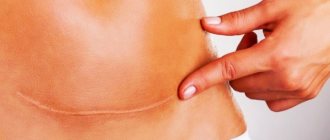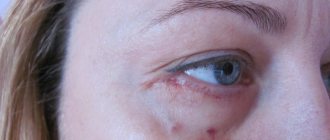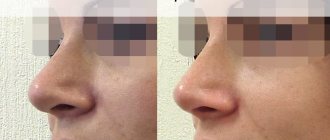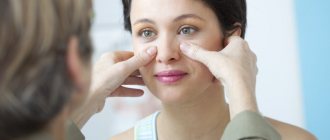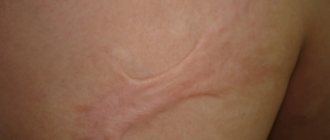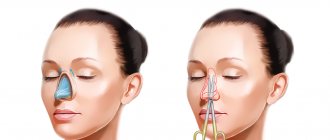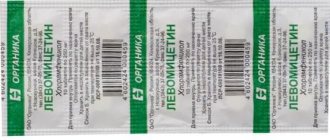Good afternoon, I'm worried about how my skin will look after the cast is removed. Tell me, is there anything I can do to keep my skin beautiful?
Proper skin care before and after rhinoplasty is very important. Why? The thing is that the skin is subjected to serious impact, both during the operation and after. Firstly, it is often treated with antiseptic solutions, and secondly, part of the face is under plaster for a long time without the possibility of cleansing it. As a result, problems may arise with the treatment of the skin.
Types of scars and their characteristics
In modern medical classification, there are four types of scars:
- Normotrophic. Minor structural flaw. Has a light shade, partially reduced elasticity. If necessary, it can be masked with standard cosmetics. Effectively eliminated by complex skin treatment procedures. Over time, it disappears from the surface of the epidermis;
- Atrophic. It is characterized by a change in skin tone in the problem localization, as well as the formation of various deep-seated flaws in the form of pits, depressed scars, and so on. It has low elasticity, since the main part of the problem area contains connective tissue. An atrophic scar does not cause discomfort, therefore it is considered solely as a persistent aesthetic defect;
- Hypertrophic. A complicated pathological type of scar, characterized by strong changes in the shade of the epidermis, a significant increase in the volume of connective tissues rising above the normal structural epidermis. The area around it regularly itches and becomes inflamed. Localized tightness is felt, the elasticity of the soft tissues is practically absent;
- Keloid. The most problematic type of scar. In appearance it is similar to hypertrophic, but is unstable: it not only rises above normal skin, but also grows beyond the limits of early skin damage, occupying large areas of the epidermis. A pathological keloid scar causes severe itching, pain, and in some cases creates the preconditions for degeneration into benign and malignant tumors.
Causes of scars on the nose
The direct cause of the appearance of a scar, regardless of location, is damage to the skin of sufficient depth and width. As part of the basic process of regeneration of the epidermis, connective tissues grow, causing formations of one type or another. Typical situations include:
- Direct mechanical damage. Injuries, careless handling of products and objects, etc.;
- Diseases . A number of severe skin diseases or systemic pathologies provoke scarring of tissue in the facial area;
- Thermal chemical burns . The appearance of the scar will depend on the extent of the pathological process;
- Surgical intervention. Classic surgery in the nose area often leaves behind scars.
Causes of scars
- Burns . Everyone knows about thermal scars from high temperatures. For example, this is a burn from steam or boiling water.
- Mechanical. Mechanical causes include household injuries, animal bites, careless shaving, and so on.
- Chemical. Doctors are of the same opinion: chemical burns are the most dangerous. In addition to the fact that it leaves terrible scars, such a burn poses a threat to life and health.
- A cold injury or cold burn is no less terrible than a regular one. A striking example of a cold burn is frostbite.
How to get rid of a scar on the nose and bridge of the nose
As part of possible measures, conservative therapy and a number of special skin treatment procedures (cosmetological and surgical) are used. As an addition, the rationality of using individual folk recipes is considered.
Use of drugs
As part of the complex treatment of scars of any type, local remedies are used predominantly. The choice of this group of medications is obvious - their components do not penetrate the systemic bloodstream and are therefore safe, which predetermines the possibility of long-term use.
The basic treatment is the use of corticosteroid ointments. They contain an active ingredient that reduces the activity of the inflammatory process. Secondarily, glucocorticosteroids weaken a potentially overactive immune response to treatment.
As an alternative to topical application, dermal injections of steroids are made into the structure of the scar, which induces its elastination.
In parallel with steroids, ointments and gels based on allantoin and dexpanthenol are used. The first component promotes partial destruction of connective tissues by softening them. The second one starts the process of regeneration of the normal epidermis, which contains pigments, hair follicles and other necessary structural inclusions.
Their multilayer structures contain non-woven material, a silicone base and a bottom impregnation with regenerating substances. After installation on problem skin, the products form an occlusive effect, reducing moisture loss, creating an optimized environment for the natural healing of the damaged area of the epidermis.
In addition, the risks of fibrous tissue proliferation and the formation of hypertrophic and keloid scars are reduced. There are no special contraindications for this type of therapy.
In general, ointments and gels for scars, as well as patches, are not used in cases of hypersensitivity to the ingredients of the products, the presence of open wounds, unhealed scars and skin diseases.
Treatment with traditional methods
It should be immediately noted that any traditional medicine recipes are effective only against normotrophic scars that do not have a significant amount of connective tissue and pathological signs of excess growth.
At the same time, these types of treatment options do not replace full-fledged drug therapy, much less surgery (if necessary), being only an addition to physical therapy, previously agreed upon with the doctor. Possible options:
- Paraffin. A sufficient amount of the product is spread out in a water bath and mixed with beeswax in a one to one ratio. The combination is applied to the problem area of the nose and left on for one hour. The procedure is repeated several times a day for 2 months;
- Honey. Traditional doctors claim that high-quality natural fresh honey, regularly rubbed into a scar, promotes its resorption with the parallel formation of normal skin. On average, the course is designed for three times daily use for 30-40 days;
- Onion juice. Buy one head of large fresh onion and squeeze the juice out of it. Apply the resulting liquid to the scar on the nose or bridge of the nose up to 4 times a day for several months. As a supplement, apply a compress based on this liquid at night.
Removing scars using special procedures
In addition to conservative therapy and traditional methods, which are essentially auxiliary methods for getting rid of pathological scars on the nose, special procedures are actively used. The most famous and effective:
- Chemical peeling. The event is organized within a well-equipped cosmetology salon by an experienced specialist. The essence of the procedure is the use of a number of substances applied to the skin for direct chemical destruction of connective tissue. Depending on the required depth of peeling penetration, fruit acids, TCA and phenols are used;
- Microdermabrasion. It is micro-resurfacing of the skin using ultrafine aluminum oxide crystals. The substance exfoliates the cellular structures of connective tissues, partially aligns fibrous formations and smoothes the epidermis in problematic areas;
- Mesotherapy . Effective for getting rid of atrophic scars. It is a microinjection of your own fat deposits into the problem area. In parallel with this procedure, appropriate injections of the intercellular matrix and stem cells are carried out into the defect, which creates the prerequisites for the elastification of the connective tissue, its partial destruction and restoration of the full epidermis;
- Laser resurfacing. It is the destruction of keloid or hypertrophic scars using a directed high-strength laser beam. The relatively minimally invasive procedure is similar to classic surgical excision, but is performed bloodlessly and does not provoke many potential complications such as secondary bacterial infection;
- Cryodestruction. Liquid nitrogen is used as an active substance that destroys connective tissue in the area of the nose scar. In general, the basic approach is the same as laser resurfacing, but the effect is more pronounced after the first session of the event;
- Surgery. Represented by standard excision, Z-plasty, skin transplantation, and other measures as necessary. It is performed only in a hospital setting by an experienced surgeon.
All the methods described above have a number of contraindications:
- The presence of unhealed wounds and scars that are in an unstable condition;
- Individual intolerance to chemicals, abrasive components and other work products, liquids, tools used as part of basic activities;
- Any infectious lesions of the skin;
- Age under 16 and over 60 years old;
- Pregnancy and breastfeeding;
- Any severe chronic diseases in the acute stage;
- The presence of moles, benign and malignant tumors;
- Recent cosmetic or plastic procedures - facelift, Botox injection, installation of implants, etc.;
- Other contraindications determined after an individual examination by the attending physician.
FAQ about home removal
- Who is suitable for homemade facial scar removal? Any age and gender. The home methods that we have prepared have proven themselves only from the best side. Before use, we recommend doing an allergy test.
- What problems can patients solve with facial scar removal at home? Remove stretch marks, scars and scars. Reduce postpartum stretch marks, acne scars and acne scars.
- Benefits of home facial scar removal? Easy to use, safe ingredients.
- Disadvantages of home facial scar removal? Waiting for results from 2 months, low effectiveness, there is a risk of allergies.
- Who is not suitable for home methods for removing scars and scars? Patients with a predisposition to keloids. And also for people who have old, large scars and stretch marks.
- Is it possible to remove keloid at home? Never. It does not depend on the size. In general, keloid scars are the most difficult to correct. Usually, home remedies have no effect on keloids.
- Is it possible to remove an atrophic scar on the face at home? A small atrophic scar can be made less noticeable at home. But old and large is almost impossible.
- Side effects of treating scars at home. Excessive use of harsh products and acids at home can aggravate the skin condition. For example, for sensitive skin you cannot use baking soda every day - the epidermis will be overdried. As a result, inflammation will begin.
- Are the results of home facial scar removal permanent? In almost all cases, the results will last forever. In some cases, when a hypertrophic scar has not been completely removed, it may become inflamed. And even start to grow. Scar growth or discomfort is a reason to consult a specialist.
- How to remove normotrophic scars on the face at home? You can try to correct small normotrophic scars at home. To do this, you can use one of the simple methods we presented above. If the nomatrophic scar is large enough and old, we recommend trying home dermabrasion. To correct any fresh and small normotrophic scar, we recommend using lotions with cocoa butter. And in order for the oil to work 100%, be sure to use a scrub or peeling first.
- How to remove burn scars on your face at home? It is quite difficult to reduce, let alone remove, a post-burn scar at home. Firstly, it all depends on the type of burn and the type of scar. Chemical burns should never be treated independently, as they can cause harm to health. Small thermal burns can be corrected independently, but only after they have completely healed. It is better to correct a burn scar on the face using gentle methods, such as the aloe method. If there is a large scar on your face from a burn, then we recommend not to waste time on self-medication, but to consult a specialist. Don't forget, the sooner you start removing a scar, the greater the chances of success. The older the scar, the more difficult and longer it takes to remove. In the BEFORE and AFTER photo below you see an excellent intermediate result of removing post-burn scars on the face. The boy’s parents wisely did not listen to the advice of neighbors and other doctors who advised “to let the child grow up.” It had a positive effect that the parents did not waste time on self-medication, but immediately contacted our clinic.
The result after 3 sessions of laser removal of a post-burn scar at Coolaser Clinic. Doctor Melnichenko L.S.
12. How to remove a scar on the lip at home? It all depends on its size and type of scar. If it is a keloid or a hypertrophic scar, it will not be possible to completely remove it at home. Lips are a very tender and delicate area. To correct a small scar on the lip, we recommend home remedies with lavender oil or baking soda. Harsh products like cucumber lotion can damage the delicate skin of your lips.
Features of a keloid scar on the nose after piercing
As modern clinical practice shows, keloid scars usually do not form after a piercing procedure. Normally, the prerequisites for the formation of a normotrophic scar are formed after piercing or nose piercing, which resolves quite quickly.
Possible triggering circumstances:
- Genetic predisposition . It is a scientifically proven fact that there is a high risk of keloid scar formation in people whose close relatives have a history of benign and/or malignant tumors;
- Improper conduct of the event. Obvious mistakes by the piercer can lead to the formation of pathological scars;
- Failure to comply with hygiene standards and standard regulations during and after piercing.
Keloid scars do not resolve on their own and require complex treatment – both primary medical and procedural-surgical.
Scars on the nose after rhinoplasty
As part of rhinoplasty, small scars of a normotrophic or atrophic type are formed, which disappear within a few months when the recommended measures are taken. Hypertrophic or keloid scars in this case are a clear pathology. It may indicate the following circumstances:
- Incorrect performance of the procedure by the surgeon due to insufficient experience, poor equipment, and other factors;
- Failure to comply with doctor’s recommendations after the event;
- Genetic predisposition to the development of keloid type scarring.
Most scars formed during rhinoplasty are effectively eliminated by various procedures. Most often it is laser resurfacing, microdermabrasion, chemical peeling. In some cases, repeated corrective surgery may be required.
Victor Systemov - expert of the 1Travmpunkt site
Scars are always a nuisance, regardless of the cause. Even if it's just a small acne scar. Firstly, it has a negative imprint on our appearance. Secondly, a reminder of past unpleasant events. But today there are many ways to deal with scars and scars. In this article we will talk about how to remove a scar stain, get rid of marks after cuts, and also make a scar less noticeable after a cesarean section or appendicitis.
Removing scars using pharmaceutical products
- Vitamin K cream
Vitamin K, which is found in leafy greens, improves blood clotting. When used topically, vitamin K cream reduces stretch marks, scars, and scars.
A homemade version of the cream is also suitable: mix 1 ampoule of vitamin K (pharmacy) with 50 ml of baby moisturizer. Store the composition in a non-metallic jar in the refrigerator for no longer than 7 days.
Bonus: reduces puffiness and evens out tone.
- Heparin ointment
Heparin ointment costs a penny, but its properties will replace an entire cosmetic arsenal. Heparin ointment removes any hematomas and bruises (including under the eyes).
Application: Apply heparin ointment daily to stretch marks, scars and scars. Don't forget to take a photo before treatment! Then after a month you will be able to compare how far the scars have gone. Suitable for removing old scars.
Let's say from experience: heparin removes stretch marks, small scars and cicatrices very well, as well as bruises and hematomas.
- Badyaga
Badyaga cream is almost as effective in removing stretch marks and scars as heparin ointment. There is only one fundamental difference: badyaga is effective only for fresh scars.
Application : apply daily to well cleansed skin for 2-3 weeks. After applying, be sure to wash your hands. A slight burning sensation is allowed.
- Contractubex
Probably the most famous remedy for scars after acne and pimples is Contractubex. Judging by the reviews of our patients, the ointment copes well with minor stretch marks and scars.
Application: use according to instructions. It is advisable to consult a dermatologist. There are contraindications.
- Skin asset
One of the most budget-friendly ointments that will help remove minor scars and scars. It has moisturizing and wound-healing properties.
Panthenol, vitamins A and E and olive oil in the composition, with regular use, remove small scars and scars. Suitable for treating small stretch marks.
Application : apply to clean facial skin after washing 2 times a day. The results of use can be seen after 2 weeks.
How to remove scars and scars?
What types of scars are there?
- The consequences of acne are the presence of brown or red spots on the face after the pimple itself has healed. By the way, this is not a scar, as many people mistakenly believe. This is only a temporary phenomenon (no more than two weeks). The scar formed after acne is a hole or bump and remains on the human body forever. In cosmetology, such scars are divided into several groups, for example, crater scars (with small depressions on the skin) or convex scars, identical to ordinary acne. There are also scars-holes (as if the skin was pierced by a needle).
- Post-operative scars - the question of how to remove a scar after surgery is of concern to many who have experienced various types of surgical interventions and whose stitches healed slowly with consequences in the form of remaining scars on the body. The question of why some sutures heal quickly, while others, on the contrary, slowly, is associated with many factors, the main one of which is the direct load on the sutures. The smaller it is, the faster the healing occurs and the neater the scar itself looks.
- Scars are the consequences of accidents - we mean various disasters, as a result of which quite large scars can form on the human body.
Now let's get acquainted with the scars
They also come in several types:
- Hypertrophic and keloid - they usually occur after the removal of moles, but can be a consequence of acne or a result of reduced immunity. Their favorite area is the décolleté, although such scars can form in absolutely any part of the human body.
- Stretch marks are scars that form from the inside as a result of the skin stretching too quickly. This occurs due to the rupture of elastic fibers and a decrease in collagen, which contributes to the elasticity of the skin. A striking example of this is women during pregnancy, especially those carrying twins or triplets. The formation of stretch marks (stretch marks) is also possible in adolescence, both in girls and boys. This phenomenon is also quite common with rapid weight gain.
The choice of the appropriate treatment method will be determined by the appearance of the scar itself:
- if it is at the same level with the skin, then it is called normotrophic - the easiest option that does not need the help of a cosmetologist, since time will heal it;
- if a scar or scar protrudes above the skin, then it is called hypertrophic, requiring treatment (lightening and reducing its size);
- if the scar falls below the skin level, then it is called atrophic (keloid scars are the most difficult to treat, as they often grow greatly and significantly exceed their original size). White scars can be removed by injection using products that fill small depressions with hyaluronic acid in the composition. It is recommended to repeat the procedure every six months to achieve a permanent effect; you can also use dermabrasion to obtain the most uniform relief of the upper layer of skin
Prevention
- Follow safety rules to avoid cuts and other damage.
- Increase the elasticity of the skin with the help of creams and foods (vegetable oils, fats, carrots).
- When you receive a wound, take care of its hygiene, use wound-healing agents and do not pick off the sore under any circumstances.
- Eat properly.
- Avoid the sun.
Prevention will help avoid the appearance of unsightly scars. But if there is already a scar, then you definitely need to fight it.
Adviсe
If a scar appears after a wound or surgery, then the first actions should be taken immediately. After removing the stitches, you need to start using creams to absorb scar tissue as soon as possible.
One of the most effective at the moment is Contractubex cream. In many cases, the use of this remedy alone is sufficient.
If after applying a course of cream, traces of the scar are still visible, then you can use the peeling procedure.
During a chemical peel, special reagents are applied to the skin, resulting in the removal of the top layer of skin. Thanks to this method, you can remove scars on the arm or other part of the body.
If the scar forms a dent or pit on the surface of the skin, special dermal fillers can be used to remove it.
Cosmetologists usually use collagen or a special hyaluronic acid gel. As a result, the skin is evened out. But this procedure will need to be repeated every few months.
If you want to get rid of unpleasant memories of a scar forever, you can use laser therapy. This method helps to smooth out the scar from the surface of the skin, leaving almost no marks.
To remove a scar with a laser, local anesthesia is often used. Treatments may vary depending on the laser. There are some that remove the top layers of skin, giving it a more natural look. And subsequently the scars disappear.
Other lasers penetrate the lower layers of the skin and stimulate collagen production. This way, you can get rid of scars from the inside.
If the scar is very large or there are many of them, then you can resort to a surgical method to remove them. There are several such methods. For example, you can cut out the scar and apply intradermal sutures.
You can also do plastic surgery to change the contours of the scar. Or cut out the scar for the purpose of subsequent skin transplantation. There is a surgical method called expander dermotension.
It consists of sewing a silicone bag (expander) into the area next to the scar, and a physiological solution is injected into it. As a result, the code above the scar stretches. After this, the pouch is removed, the scar is excised, and the skin is tightened.
How can I remove scars from cuts on my hand?
If the scar is after appendicitis
If the scar is fresh, then for prevention and treatment (by the way, the effectiveness of use has long been proven), it is advisable to use special ointments.
What ointments remove scars?
The fact is that there are several absorbable ointments, among which the best are considered:
- Contractubex;
- Kelofibrase;
- Dermatix;
- Fermenkol;
- Mederma
- Scarguard liquid cream;
- silicone gel and spray Kelo-kot
In the first months of scar formation, silicone plates (for example, Spenko) and patches can be used.
If cases are more advanced, other treatment methods will be required:
- plastic surgery or surgical excision (removal of the scar followed by cosmetic stitches);
- physiotherapeutic procedures (ultrasound, electrophoresis, magnetic therapy) - using this method, scars are destroyed from the inside (by the way, this method is not suitable for dark-skinned people);
- hormonal treatment - injection into scar tissue until the desired result is achieved;
- laser removal - by evaporating scars, which makes them flat, as well as by laser remodeling to make many micro-holes in the scar, leading to tissue contraction and ingrowth of healthy cells
How does scar tissue differ from healthy tissue?
- The difference between scar tissue and healthy tissue is that in healthy tissue, collagen fibers are located randomly, chaotically, and most often crosswise. This arrangement of fibers in relation to each other creates a uniform skin structure. This difference is clearly visible in the microscope photograph below.
Under a microscope, you can see the difference in the arrangement of collagen fibers in healthy tissue (left) and scar tissue (right).
- In scar tissue, the fibers are located parallel to each other - longitudinally in one direction.
- Charm fabric lacks hair follicles and sebaceous glands.
The schematic drawing shows: On the left is healthy tissue, and on the right is tissue with a scar. Scar tissue lacks hair follicles and sebaceous glands. Collagen fibers in healthy tissue are arranged crosswise, while in scarred tissue they are arranged in parallel.
How to remove a scar after a caesarean section?
How to choose the right method?
Scars on the face can appear for various reasons. Gross defects, as a rule, appear as a result of injuries and burns; postoperative scars are less noticeable. In some cases, scars appear after acne or insect bites. The nature of the scars directly depends on the type of negative impact:
- Normotrophic scars. Appear as a result of minor cuts and abrasions on the cheeks and nose, herpes on the lip. Scars may appear after rhinoplasty or cosmetic surgery. These scars are flesh-colored or, in most cases, barely noticeable. They are easy to get rid of with proper and timely treatment.
- Atrophic scars. They occur at the site of acne, burns, chickenpox, after improper removal of moles and papillomas. The scars are slightly pressed into the skin and have a pink tint.
- Hypertrophic or pathological scars are rough, dense in structure, with a pink-bluish color. They occur as a result of severe burns, deep wounds, accompanied by suppuration. Such scars can be complicated by the appearance of trophic ulcers on their surface.
- Keloids. They have a tumor-like structure with a pronounced pink-blue color. Keloids appear as a result of surgical interventions, deep wounds, after animal bites and severe burns.
It will be more difficult for older people to get rid of scars due to the minimal production of collagen and elastin - the main structural proteins of the skin. Scar treatment will be more successful if it is started as early as possible, when the scars are still fresh.
Fact! The most difficult areas to deal with are keloid scars in the area of the nose, eyes and lips. Such defects require mandatory treatment.
Coconut or olive oil to reduce acne
Olive or coconut oil have a wide range of medicinal effects because they are natural and herbal. Coconut oil contains natural acids:
- lauric
- caprylic
- capric
These acids help stimulate collagen production and heal damaged skin
Olive oil nourishes the skin and helps keep it hydrated with a large amount of vitamins that affect the healing process of post-acne scars
Gently massage the scar with olive or coconut oil for 5-10 minutes several times a day.
Fighting with improvised means
If the scars were formed as a result of minor skin damage not so long ago and have a small surface area, then you can deal with them at home. Getting rid of scars consists of several stages:
- Grinding the scar using special brushes, washcloths, and sponges. It is best to apply scrubs to problem skin at this stage. The procedure should be performed no more than once a week, and after the procedure, apply cream to the damaged area.
- Homemade face masks. Lemon masks are good for removing acne scars; they will help even out your skin tone. Aloe-based masks at home will speed up regeneration, and blue or green clay products will make the scar less noticeable.
- To remove scars at home, you can use peelings based on fruit acids and coffee. A good effect is achieved when using products with the addition of natural essential oils (almond oil, rosemary oil, grape seed oil). Peels help even out the skin and make the complexion more even.
- Lotions and compresses based on apple cider vinegar, essential oils and clay are also popular. These products are quite easy to make at home and are suitable for daily use. With regular use, skin tone improves significantly.
Grinding
An excellent way is to polish the scar. To do this, you will need a massage brush, sponge or washcloth. You need to choose a stiffer brush.
The main thing in this procedure is to know when to stop. If you damage the skin, you can only make the situation worse.
The procedure should begin by applying a scrub to the skin. Then intensively, moving in a circle, massage the area with the scar. Carrying out this procedure regularly will help you forget about the defect over time.
It is worth remembering that after any impact on the skin, it needs nutrition, so it is recommended to complete the procedure by applying a moisturizer.
You can replace the brush with a soft nail file. But it is important to sand the leather very carefully so as not to damage or harm it. Sanding should be repeated no more than once every 7 days.
What can you find in a pharmacy?
How to remove a scar on your face if home methods don’t help? The most common method for treating scars is medication. Ointments, gels, creams and patches are widely used. According to reviews, the best help is:
- Contractubex cream. Active for all types of scars (even keloids). Slows down the formation of scar tissue. The cream helps even out the tone of the face and reduces the depth of the scar. Carrying out physiotherapy with ultrasound significantly increases the effectiveness of the drug. The cream copes well with rough defects and scars after rhinoplasty.
- Gel Dermatix. Forms a protective film on the surface of the scar, penetrating into the deeper layers of the skin, lightens the scar.
- Clearvin cream is plant-based. It is popular due to its low price; most reviews about the product are positive. The cream activates tissue regeneration processes and reduces scar healing time. The product helps hide acne scars.
- Mederma ointment increases skin elasticity, smoothes color, making scars less obvious.
- Hydrocortisone ointment has a pronounced smoothing effect. With regular use, scars become almost invisible.
Among the patches, the most praised are silicone-based products, Mepiform and Dermatix. They have a good moisturizing and compression effect, reducing scar defects.
Fact! Silicone-based patches help smooth out and hide even rough scars.
The above remedies are used for 2-4 months if the scar is fresh, if the scar is old, treatment lasts at least six months.
Some doctors prescribe general tonics and vitamins, which also promotes regeneration processes.
All medications have contraindications and side effects. To choose the right drug, it is better to consult a doctor.
Folk recipes
If the question arises of how to remove a scar on the face, then you can turn to traditional medicine for help. At home, you can make various remedies that will help solve the problem and will not “hit” your wallet.
Aloe
You need to use an aloe leaf from the bottom of the plant. To begin with, you should wipe it well to remove dirt, then remove the skin and crush the pulp.
Use the pulp as a mask, applying it to the scar. After half an hour, wash off. This is a fairly simple but effective method, provided it is used regularly.
Vitamins
With the help of vitamin E, which helps restore skin cells, you can try to get rid of the defect. This vitamin in oil form is sold in any pharmacy.
This vitamin should be lubricated daily on the scar; it can be used on the entire face.
Clay
Clay will help remove scars on the face. If you mix it with water daily and apply it to the affected area, after a while the scar will begin to dissolve.
For such procedures, it is better to use green clay, but for lack of a better one, any will do.
Lemon
The scar on the face may not be very large, for example, the spots that remain after squeezed out pimples are also small scars, because the skin has been damaged.
In this case, the whitening property of citric acid will help. You can wipe your face with a lemon slice, or you can squeeze out the juice and use a cotton pad soaked in lemon juice.
Mumiyo
This tool has been used for quite a long time. It is believed to help with health, which is why people drink it. Shilajit can also help in the fight against scars. Add 1 gram of this product to the face or body cream, depending on where the defect is located. Apply this cream for half an hour.
Butter with egg
An effective remedy in the fight against scars is the following recipe. To prepare it you will need:
- sea buckthorn oil 4 tablespoons;
- beeswax 0.5 spoons;
- 1-2 sachets of streptocide;
- 1-2 yolks.
Mix wax and oil and bring to a boil. Cool slightly and add the yolk and streptocide, making sure that the temperature of the mixture is such that the yolk does not cook.
Mix everything thoroughly and use it on areas with scars. This remedy is also effective for use on burns.
Acid
You can try to eliminate a defect in the form of a scar on the face with the help of fruit acids. They are used in peeling. These are quite strong remedies.
This type of peeling can be found in a salon, but you can also carry out this procedure at home. To exfoliate yourself using fruit acids, you will need to add 1 part apple cider vinegar (6%) to 3 parts water.
Apply a cloth or gauze soaked in this solution to the problem area. Remove after a quarter of an hour. With regular procedures, the scar will begin to smooth out almost immediately. The main thing is patience.
Drastic methods in the fight against scars
If treatment of the scar at home, as well as with the help of medications, does not bring the desired results, you can resort to a type of scar treatment such as removal using laser therapy.
During the procedure, a special laser that triggers deep tissue regeneration improves the production and synthesis of collagen and elastin - substances responsible for the stretchability and contractility of the dermis.
The procedure is not budgetary, but the effect is noticeable immediately after the first procedure, and in some cases (with normotrophic and atrophic scars) one procedure is quite enough for the complete disappearance of the scar.
- painless procedure;
- does not require hospitalization;
- performed without anesthesia;
- no special care required;
- Suitable for all skin types.
The result of treatment depends on how long ago the scar formed. The size and location of the defect also matters. With the help of laser therapy, it is possible to get rid of a scar by 100%, provided that the formation of scar tissue on the skin of the lips, forehead and cheeks is treated from the first days. It is necessary to follow all doctor's recommendations for skin care after this procedure.
You can remove a scar from any part of the body. Most often, laser resurfacing is used to remove a scar on the eyebrow after a dissection or poor-quality piercing procedure. A scar on the lip caused by a herpetic infection can also be removed using a laser.
Interesting! A scar on the nose after rhinoplasty is also removed using laser resurfacing.
Care after the home procedure
Cosmetologists and dermatologists have been talking for years about simple rules that will support the skin and improve the effect of any products.
A) Thorough cleansing
Before applying a home remedy for stretch marks or scars, you need to cleanse your skin. To do this, it is recommended to use a scrub or gentle peeling.
Scrubs and peels exfoliate dead cells, allowing healthy skin to grow. Stimulate the regeneration process and improve the effect of home treatments.
B) Post-hydration
Do not forget that after any home method for removing scars and stretch marks, the skin needs to be moisturized. Any cream that has proven itself in your cosmetic bag will do.
We recommend trying baby creams or 99% aloe vera gel. Why does skin need to be moisturized? Dry and dehydrated skin does not absorb vitamins well and is almost unable to renew itself.
Beauty injections for facial scars
How to get rid of scars on your face? The answer to this question is known to cosmetologists. However, it is better to use the services of doctors if other methods are ineffective.
Injection treatment of scars consists of the popular procedures of mesotherapy and ozone therapy. During these procedures, medications are injected under the skin. Ozone therapy uses active oxygen or ozone, which improves tissue regeneration, accelerates healing, and gives the skin firmness and elasticity. During mesotherapy, several drugs are injected subcutaneously, which are selected by the doctor individually for each patient.
Interesting! The easiest way to remove a scar on the forehead is with beauty injections. But it will not be possible to hide scars after rhinoplasty in this way.
These procedures help get rid of scars on the forehead, lips and eyebrows. In this way, a scar on the cheek after plastic surgery and skin defects after acne are usually removed. A course of injections will help hide the scars, but it will be possible to get rid of them completely if treatment is started early.
Liquid nitrogen is used to treat hypertrophic scars and keloids. This procedure is called cryodestruction. It is carried out in special clinics. Another effective method for removing rough, dense scars is phonophoresis. The procedure consists of deep micromassage of the scar. Under the influence of ultrasound, cellular metabolism and local blood circulation are activated. The procedure is well suited for patients with scars formed after rhinoplasty and facelift.
Interesting! With Phonophoresis, the doctor introduces cosmetic substances into the skin, which significantly tighten the skin, creating a lifting effect. This procedure increases skin elasticity and helps hide wrinkles.
Microdermabrasion is another popular procedure that is performed using a special device or cosmetic instruments. The procedure removes the top dead skin cells, evening out the skin tone. Of course, the method helps hide defects, but a significant disadvantage of this method is pain.
Interesting! Cosmetologists rarely recommend microdermabrasion after rhinoplasty, since there are many nerve endings in the incision area.
What you need to know about scars after rhinoplasty?
Most patients, even before surgery to correct the shape of the nose, have natural questions. Will there be any scars left after this? What will need to be done to get rid of scars after rhinoplasty?
A scar is the connective tissue that appears at the site of the incision. Therefore, after any operation it remains. The question is what size it will be, where it will be located, and whether it will be noticeable to others.
Important! If you turn to a professional surgeon, the scars after the operation will most likely be practically invisible to others and will not cause concern to the patient, since they almost completely resolve, and we can talk about rhinoplasty without scars.
In the hands of a surgeon
The most radical method of combating a cosmetic defect is surgical treatment. The skin with scar tissue is removed, and the doctor transplants healthy skin in its place. In this case, depending on the size of the scar, as well as the severity of its removal, general or local anesthesia is used. After surgical removal of scars, the patient requires special care. Some complications are possible, such as neuralgia, hematomas and inflammation.
Important! Before surgery, the patient must undergo examination and tests.
The surgical method allows you to correct the skin texture. With small-scale interventions, you can reduce the width of the scar and even out the skin. With a complete skin transplant, there will be no trace of the defect.
The help of surgeons is necessary for people with extensive and deep scars. Indications for surgical intervention are scars after 3-4 degree burns, when skin function is significantly impaired. It is not uncommon for surgeons to perform skin grafts after open rhinoplasty, where a nasal surgery involves making an incision in the middle of the nose.
Interesting! In closed rhinoplasty, an incision is made inside the nose.
Surgical intervention
Significant damage to the skin as a result of burns, wounds, inflammation, postoperative sutures can lead to the formation of deep and large scars. The consulting specialist decides whether to get rid of them through surgery.
Surgical removal of scars on the face, including the forehead, is a plastic surgery to remove scars. After the procedure, the scars will be less noticeable, but will not disappear completely. Over time, the marks may become invisible.
For atrophic scars, contour plastic surgery is used. Injections of a gel are administered, which pushes out the scar and aligns it with the surface of the skin.
During the operation, the surgeon excises the damaged tissue and cuts out the scar, then connects the edges of the wound. A cosmetic suture is applied, which is removed after 2 days. The operation is performed under general anesthesia or local anesthesia. Rehabilitation lasts a week.
How to prevent scars?
Scars appear as a result of various skin injuries, acne, and animal bites. It is important to treat wounds during the healing stage, to prevent their infection and suppuration. Only proper care will help prevent the appearance of unsightly defects on the skin of the lips, forehead and nose.
If prevention does not help, treatment should be started immediately. In the early stages, vessels that nourish the skin remain in the scar tissue, so the effectiveness of creams and ointments is significantly enhanced, and scars heal faster. It is almost impossible to cope with old scars without the help of cosmetologists.
If you find an error, please select a piece of text and press Ctrl+Enter.
We will be very grateful if you rate it and share it on social networks
